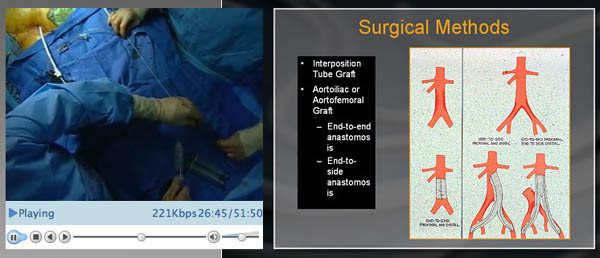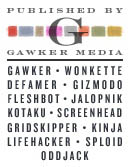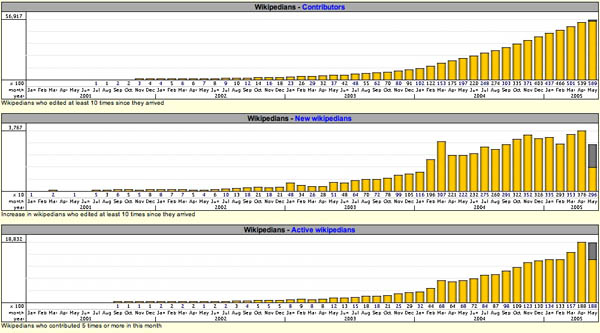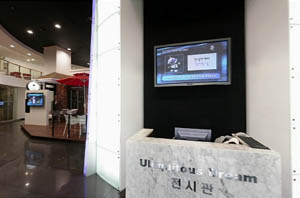“when blogs band together – a new hybrid form” – examining the phenomenon of multi-blog publications
 Launched this May by Mark Sarvas, author of Elegant Variation, the litblog co-op unites 21 literary weblogs “for the purpose of drawing attention to the best of contemporary fiction, authors and presses that are struggling to be noticed in a flooded marketplace.” The LBC blog devotes its energies, and intermittent posting, to “Read This!” – a quarterly endorsement of an obscure or undeservedly ignored book, intended to expose important works that the mainstream press has ignored.
Launched this May by Mark Sarvas, author of Elegant Variation, the litblog co-op unites 21 literary weblogs “for the purpose of drawing attention to the best of contemporary fiction, authors and presses that are struggling to be noticed in a flooded marketplace.” The LBC blog devotes its energies, and intermittent posting, to “Read This!” – a quarterly endorsement of an obscure or undeservedly ignored book, intended to expose important works that the mainstream press has ignored.
For as long as it has existed, the lit blogging community has sought to countervail the steadily shrinking coverage of books in the media, but it’s not at all clear whether their impact is felt beyond limited circles. “Read This!” seeks to amplify the strongest recommendations, resolving the bloggers’ voices into one crystalline note of praise that, hopefully, people will be unable to ignore.
The first volume to receive the LBC imprimatur is Kate Atkinson’s “Case Histories,” a literary riff on the traditional crime novel. The choice was by no means unanimous. Some complained that the book was not sufficiently needy of promotion, seeing as Atkinson’s previous novel, “Behind the Scenes at the Museum,” won the Whitbread award, and “Case Histories” is published by Little, Brown – not exactly a fringe press. But in the end, the opposing camps were reconciled (allowing the “minority opinion” to vent itself) and agreed to throw their collective weight behind Atkinson’s book. We have yet to see whether the endorsement will have any affect on the book’s sales (inclusion in Forbes’ “Best of the Web” certainly won’t hurt), but when enough influential voices start talking about the same thing, someone is bound to listen.
Monthly Archives: July 2005
the paperless hospital
For all the advances in medical science, it’s incredible that the methods for organizing and distributing medical information have not kept up. A vast amount of medical error, both prescriptive and diagnostic, comes down to problems with the flow of information. All too often, the information doesn’t flow fast enough, or different information flows to different people, or the information can only flow to one person at a time, slowing down treatment and opening the door to infection.
The Guardian has a fascinating profile (via Smart Mobs) of the Oklahoma Heart Hospital (known as OK Heart), which has the distinction of being one of the first hospitals in the world to go entirely digital. A central computer connects to bedside screens in each room where patient records can be instantly called up. Consequently, doctors, nurses and pharmacists are always on the same page – the same digital page – greatly reducing the length of patient stays, and minimizing error. Of course, technology alone will not transform medicine – it’s the people that ultimately determine the quality of care – but the case of OK Heart is a compelling one.
There is a practical reason for using technology this aggressively: the longer you stay in hospital for the same treatment, the less chance you have of getting out of it alive. While the average stay for serious heart patients in the US is five days, the OK Heart average is 2.7 days, and falling. Doctors don’t have to chase x-rays and MRI scans, which are in the patient’s record before they get back to their room, and nurses don’t chase the doctor’s notes, which are transcribed remotely as soon as they are dictated.
It is a dramatic transformation in working practices: at the Indiana Heart Hospital, a digital hospital that runs along similar lines, internal research shows a reduction of 85% in medication errors, avoidable delays down by 65% and reductions in the cost of updating records by 45% compared with paper-based hospitals. Doctors also cut the time they spend updating records by a third.

It’s also worth visiting OK Heart’s website, where you can a watch a fascinating June webcast of surgeons at work on an Endovascular Abdominal Aortic Aneurysm. The surgeons talk the viewer through the procedure, while diagrams appear to the right for clarification. It’s a highly informative program and suggests how much the medical sciences will benefit when digital textbooks can bring the operating theater directly to the student.
when blogs band together 2 – Gawker Media
“when blogs band together – a new hybrid form” – examining the phenomenon of multi-blog publications
 Few media outfits have ridden the blog phenomenon quite as cleverly as Gawker Media, the three-year-old brainchild of publisher Nick Denton. Gawker Media “takes the weblog format and applies the business model of a traditional magazine,” bringing together some of the web’s most popular rags, including Gizmodo, Lifehacker, Wonkette, and Fleshbot. With some of the highest traffic figures on the web (and the ad revenue that comes with them) it’s not a stretch to say that Gawker Media has become the Condé Nast of the blogosphere.
Few media outfits have ridden the blog phenomenon quite as cleverly as Gawker Media, the three-year-old brainchild of publisher Nick Denton. Gawker Media “takes the weblog format and applies the business model of a traditional magazine,” bringing together some of the web’s most popular rags, including Gizmodo, Lifehacker, Wonkette, and Fleshbot. With some of the highest traffic figures on the web (and the ad revenue that comes with them) it’s not a stretch to say that Gawker Media has become the Condé Nast of the blogosphere.
But unlike that goliath of the magazine world, Denton’s fledgling empire deals almost exclusively in second-hand material, and its staff is made up entirely of editors with not a writer to be found. Gawker blogs are of the pointer variety, directing readers to juicy finds around the world wide web with a splash of wit or snarky commentary. Of course, this is the formula for millions of weblogs – a couple of links with a bit of context. Denton’s coup has been to identify the best curatorial talents and collect them under a single umbrella.
The network’s flagship is, of course, Gawker, the addictive Manhattan gossip sheet, considered a must-read by society-watchers and scandal junkies. Defamer is its L.A. counterpart. Gawker Media bloggers actually receive a modest annual salary and are required to hit a minimum number of posts per day. Currently, there are 13 blogs in the Gawker tent, but the network is sure to expand. There’s even a Gawker observer blog, Gawkerist, whose author’s calculated ploy to capture Denton’s attention recently succeeded in securing him the editorship of Gawker’s urban travel blog, Gridskipper.
Gawker Media’s rise indicates that there is a broad demand for savvy, charismatic guides through the information blitz of the web. Success does not depend on getting readers to spend long stretches of time on one of the 13 sites, only on getting them to visit briefly, catching an ad or two in their peripheral vision, before getting bounced somewhere else. Gawker Media is a trampoline. It’s where people come to get bounced. This suggests that, though the author may enjoy primacy in the world of print, on the web it is more often the editor that counts.
family values and the value of video games
Steven “Everything Bad Is Good For You” Johnson has an amusing open letter to Hillary Clinton in today’s LA Times, urging the senator not to blind herself to the virtues of video games in her quest to earn moral values cred with 2008 swing voters.
Consider this one fascinating trend among teenagers: They’re spending less time watching professional sports and more time simulating those sports on Xbox or PlayStation. Now, which activity challenges the mind more — sitting around rooting for the Packers, or managing an entire football franchise through a season of “Madden 2005”: calling plays, setting lineups, trading players and negotiating contracts? Which challenges the mind more — zoning out to the lives of fictional characters on a televised soap opera, or actively managing the lives of dozens of virtual characters in a game such as “The Sims”?
when blogs band together 1 – TPM Café
“when blogs band together – a new hybrid form” – examining the phenomenon of multi-blog publications
 TPM Café is a new site from Joshua Micah Marshall, author of the immensely popular Talking Points Memo. Building on the success of his personal site, Marshall has set up a veritable fleet of weblogs by an impressive roster of writers, thinkers and activists – both established and first-time bloggers – in what he hopes to become a focal point for liberal political energies.
TPM Café is a new site from Joshua Micah Marshall, author of the immensely popular Talking Points Memo. Building on the success of his personal site, Marshall has set up a veritable fleet of weblogs by an impressive roster of writers, thinkers and activists – both established and first-time bloggers – in what he hopes to become a focal point for liberal political energies.
On the main page, you’ll find the Coffee House, a 13-author blog covering “issues ranging from public policy to the arts, books, science and religion” – the lead stories, as it were. To the side is a list of the cafe’s other blogs. The recently launched TPM Café Book Club will devote a rotating discussion space to a popular book, giving the author the opportunity to expand upon their work and engage with readers (there’s currently an interesting little spar between famed liberal activist Todd Gitlin and “What’s the Matter With Kansas?” author Thomas Frank). America Abroad brings together foreign affairs heavyweights like G. John Ikenberry, Ivo Daalder and Anne-Marie Slaughter to engage the whirlwind of American foreign policy. House of Labor is about “the future of the American labor movement,” while Warren Reports examines the American Middle Class. And there are several other blogs, including an open venue for registered readers, as well as a variety of discussion forums.
TPM Café seems to be off to a good start. It will be interesting to watch how Marshall makes the transition from blogger to editor.
when blogs band together – a new hybrid form
A million voices in the wilderness singing solo.
Most regular blog readers would agree that without aggregators like Bloglines or Newsgator, sifting through the day’s postings would be exceedingly tiresome, if not impossible. Why manage dozens of bookmarks, and plod through page after page, when a free aggregating service will keep all your favorite sites in one place, allowing for quick scanning of headlines to determine where you’d like to spend more time reading?
It’s like a newsstand stocked with publications that you yourself have syndicated. Different themes can be organized in different folders: here are my political feeds, here are my arts feeds, here are my tech feeds etc. These folders are like your daily magazines. Then there is Technorati, the web’s premier blog indexer, where readers can search over 13 million blogs by tag, keyword and prestige (number of incoming links).
Bloggers, too, have ways of tying each other together. Shout outs, quotes, comments, trackbacks, link lists – all of these serve to interweave, and this is in large part how the blogosphere has grown. Over time, certain blogs come to be associated with one another, and coherent communities emerge.
But what happens when blogs choose to aggregate themselves under a single masthead? What happens when the voices decide to group together in a chorus? Do they then become a newspaper? A magazine? A union? A league? A society? It may not yet have a name, but some blogs have in fact started banding together to form a new kind of hybrid publication that is difficult to define.
Part cocktail party, part basement pamphlet press. It’s looser than a magazine, and more conversational. It is a sort of union, but its dues are purely in the form of a blogger’s personal payload – their insight, their charisma, their dedication to certain issues, their unique voice. They are presided over by an editorial authority, but not one that gets in between the writers’ lines or sets a word limit. These are still very much blogs, and authors retain almost total autonomy. Their only obligation is to keep the good stuff coming. Over the next few days, I’ll be profiling a few of these sites. This is by no means a comprehensive list, so please don’t hesitate to recommend others that in some way fit the bill.
1. TPM Café
2. Gawker Media
3. the litblog co-op
wikipedia stats

From weblogg-ed (via Library Stuff):
- Over 4,000 new articles a day.
- An average of 14 edits per entry.
- About 57,000 people who have edited at least 10 times.
- About 2.7 million edits in May
It’s hard to deny that something is going on here. I wonder, though… Insofar as it assumes the mantle of the print encyclopedia, Wikipedia represents a migration of print-based knowledge to the web. Many of its most devoted contributors acquired their learning from a print world of libraries, books and periodicals. But what happens later, after this formative period, when your average user is someone who derives the bulk of their learning from the web (from resources like Wikipedia)? How do you maintain the Wikipedia article on the Spanish Golden Age when that same article is your primary source?
Perhaps Wikipedia’s encyclopedia-ness is just an early skin that it will eventually shed. It may well devolve into a sprawling compendium of trivia and eccentric niche outposts (in some ways, that’s what it already is). Or it may evolve further into that strange hybrid animal: a reference work on current events (as it has proven itself to be with the new pope and the London bombings). On the other hand, if serious scholars decide that Wikipedia is a legitimate resource worthy of investment, we might see it sustain itself as a reliable reference work (without, of course, losing all the trivia and current events). To do this, it might, paradoxically, need to stay grounded in the offline world.
convergence sightings
1: BLOGS AND RADIO. The NY Times profiles a new show on Public Radio International that draws its inspiration from the web. “Open Source from PRI” uses a public blog to cull topics and story ideas from registered commenters:
“Open Source will not be a show about blogs. It will use blogs to be a show about the world.”
Open Source offers podcasts of its programs, available for free subscription on Odeo and iTunes.
2. WIRES CROSSED. The Associated Press is preparing to launch an online video streaming network from which members can syndicate clips for presentation on their news sites. Clips will be streamed by member sites over branded video players that AP will provide. In exchange, AP will take a portion of revenues generated by interspersed video ads. Most news networks are racing to upgrade their sites to offer more video content alongside text (see “television merging with the web” on this blog).
korea’s ubiquitous dream hall
What if short-range time travel were possible, affording you a glimpse of the near future? What if it were as simple as buying a plane ticket? For anyone looking for tangible clues as to where today’s info tech proliferation might be leading us, a Korean Air jet to Seoul might be the closest thing to a time machine currently available. Over the past decade, South Korea has emerged as the ultimate high-tech society, making our own gadget-crazed culture look provincial by comparison. A huge portion of the Korean economy (domestic and export) is devoted to information communications technology, Korean cities lead the world in broadband penetration, and nearly three quarters of South Koreans subscribe to cellular phone services.
And that is only the beginning. The government recently announced its vision for “u-Korea,” a plan to achieve “ubiquitous communications” across the country through a blitz of products, services and infrastructure, as well as computer literacy programs targeting rural areas and the older generations that have been unable to keep up with Korea’s evolution toward network totality. An article in the Bangkok Post describes the initiative (via Smart Mobs).


Among the planned “ubiquitous” services are internet telephony, digital multimedia broadcasting, and enhanced wireless broadband coverage that can be enjoyed at speeds of up to 60 kilometers per hour. National Computerisation Agency (NCA) president Dr Chang-Kon Kim says the goal is for total broadband coverage across the country by 2007. When all of this comes together, Koreans will find themselves living in a totally wired society where handheld devices (a cross between a powerful PC and a mobile phone) are the keys to the environment.
To offer its citizens a window into the future, the Korean Ministry of Information and Communication has set up the “Ubiquitous Dream Hall,” an exposition space in downtown Seoul where visitors can explore the predicted technologies and begin to imagine new ways of life that might develop around them. There you can see a household where appliances, smoke alarm and stereo system are all wired into the same network, and family life centers around an interactive television; or a cafe where cappuccinos are ordered on wall-sized touch screens, then delivered by little service robots; or a car that instructs you where to drive; or a new form of interactive street advertising in which images on the floor change in response to pedestrians’ footsteps. The Dream Hall also features an exhibit charting the development of household and communication technologies over the past 30 years, projecting u-Korea into a historical continuum. Whether ubiquitous communication will result in a better life for Koreans remains to be seen, but the government is betting it will be a surefire strategy to keep the economy booming. I’d be concerned for Korea’s sanity.
See also in Ohmy News, Korea’s citizen newspaper:
“International Citizen Reporters Get a Taste of IT Korea”
“In the Future Your House Will Nitpick You”
citizen journalists or citizen paparazzi?
If acts of terrorism are intended to send a shock through the nervous system of societies, then the media acts as the synapse chain, firing trauma through the body politic. The media society acts like an animal with a mind of its own, and now it’s ordinary people (not just the professional media), newly equipped with recording gadgets galore, who perform the duties of nerve endings.
Shaken by a second round of attempted bombings on London trains and buses, my thoughts return to the buzz of a just a couple weeks ago – all the talk about citizen journalism’s big moment, the photos and video clips captured on phones and digital cameras, instantly proliferating through the media consciousness. During that time, Mark Glaser wrote a thoughtful piece for USC’s Online Journalism Review (OJR), in which he asks whether what we are seeing is not, in fact, the rise of a sordid, citizen paparazzi. Glaser’s article contains some sobering passages describing the scenes of carnage and the crowding amateur photographers, their phones outstretched. This is from a couple of posts (1, 2) Glaser found by a British blogger who survived the attacks:
The victims were being triaged at the station entrance by Tube staff and as I could see little more I could do so I got out of the way and left. As I stepped out people with cameraphones vied to try and take pictures of the worst victims…
…These people were passers-by trying to look into the station. They had no access, but could have done well to clear the area rather than clog it. The people on the train weren’t all trying to take pictures, we were shocked, dirty and helping each other. People were stunned, but okay. The majority of the train was okay as I walked from my carriage (the last intact one) down through the train I saw no injuries or damage to the remaining four or so carriages. Just people dirty and in shock. The other direction wasn’t so pretty, but you don’t need an account of this and what I saw, watching TV is enough.
It’s not yet clear whether this latest string of botched attacks was a reprise by the group responsible for July 7, or whether these were copycats, operating in the psychological wake of the original bombings. Copycat crime is nothing new, and it would be a stretch to attribute it to an increase in digital rubbernecking (I’m of the opinion that violence in the media makes people more afraid, not more violent). There’s no doubt that some of the amateur photos and clips helped convey the reality of the attacks in a way that journalists could not. But I can’t help but feel that our techno-voyeurism is one of the things that makes terrorism so effective beyond the immediate points of impact. We are one, big, hyper-sensitive nerve. A few, well aimed pokes can send spasms through the whole system.
